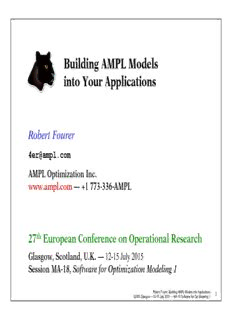Table Of ContentBuilding AMPL Models
into Your Applications
Robert Fourer
[email protected]
AMPL Optimization Inc.
www.ampl.com — +1 773-336-AMPL
27th European Conference on Operational Research
Glasgow, Scotland, U.K. — 12-15 July 2015
Session MA-18, Software for Optimization Modeling 1
Robert Fourer, Building AMPL Models Into Applications 1
EURO Glasgow —12-15 July 2015 —MA-18 Software for Opt Modeling 1
Building AMPL Models
into Applications
Algebraic modeling languages were developed with the goal of making
optimization models much easier to develop, debug, and maintain.
However it is not necessary to give up these advantages when
embedding a model into a larger system or deploying it to users. Two
distinct facilities of modeling languages are commonly used to
integrate models into applications:
Scripting brings the programmer to the modeling language,
extending the language so that the same constructs convenient for
describing a model can also be used to specify how the model will
be used in a broader context.
APIs bring the modeling language to the programmer, providing
access to model objects and methods for applications written in
general-purpose programming languages.
The strengths of these two approaches are contrasted by comparing
implementations of column-generation schemes for cutting problems.
Robert Fourer, Building AMPL Models Into Applications 2
EURO Glasgow —12-15 July 2015 —MA-18 Software for Opt Modeling 1
Outline
Simple roll cutting example
Solution via command language
Sensitivity analysis via scripting
Roll cutting by pattern enumeration
via scripting
via MATLAB API
via Java API
Roll cutting by pattern generation
via scripting
via MATLAB API
Robert Fourer, Building AMPL Models Into Applications 8
EURO Glasgow —12-15 July 2015 —MA-18 Software for Opt Modeling 1
Roll Cutting Problem
Motivation
Fill orders for rolls of various widths
by cutting raw rolls of one (large) fixed width
using a variety of cutting patterns
Optimization model
Decision variables
number of raw rolls to cut according to each pattern
Objective
minimize number of raw rolls used
Constraints
meet demands for each ordered width
Robert Fourer, Building AMPL Models Into Applications 9
EURO Glasgow —12-15 July 2015 —MA-18 Software for Opt Modeling 1
Roll cutting
Mathematical Formulation
Given
(cid:1849) set of ordered widths
(cid:1866) number of patterns considered
and
(cid:1853) occurrences of width (cid:1861) in pattern (cid:1862),
(cid:3036)(cid:3037)
for each (cid:1861) ∈ (cid:1849) and (cid:1862) (cid:3404) 1, . . . , (cid:1866)
(cid:1854) orders for width (cid:1861), for each (cid:1861) ∈ (cid:1849)
(cid:3036)
Robert Fourer, Building AMPL Models Into Applications 10
EURO Glasgow —12-15 July 2015 —MA-18 Software for Opt Modeling 1
Roll cutting
Mathematical Formulation (cont’d)
Determine
(cid:1850) number of rolls to cut using pattern (cid:1862),
(cid:1862)
for each (cid:1862) (cid:3404) 1, . . . , (cid:1866)
to minimize
(cid:3041)
∑ (cid:1850)
(cid:3037)(cid:2880)(cid:2869) (cid:3037)
total number of rolls cut
subject to
(cid:3041)
∑ (cid:1853) (cid:1850) (cid:3410) (cid:1854) , for all (cid:1861) ∈ (cid:1849)
(cid:3037)(cid:2880)(cid:2869) (cid:3036)(cid:3037) (cid:3037) (cid:3036)
number of rolls of width (cid:1861) cut
must be at least the number ordered
Robert Fourer, Building AMPL Models Into Applications 11
EURO Glasgow —12-15 July 2015 —MA-18 Software for Opt Modeling 1
Roll Cutting
AMPL Formulation
Symbolic model
set WIDTHS;
param orders {WIDTHS} > 0;
param nPAT integer >= 0;
param nbr {WIDTHS,1..nPAT} integer >= 0;
var Cut {1..nPAT} integer >= 0;
minimize Number:
sum {j in 1..nPAT} Cut[j];
subj to Fulfill {i in WIDTHS}:
sum {j in 1..nPAT} nbr[i,j] * Cut[j] >= orders[i];
(cid:3041)
∑ (cid:1853) (cid:1850) (cid:3410) (cid:1854)
(cid:3037)(cid:2880)(cid:2869) (cid:3036)(cid:3037) (cid:3037) (cid:3036)
Robert Fourer, Building AMPL Models Into Applications 12
EURO Glasgow —12-15 July 2015 —MA-18 Software for Opt Modeling 1
Roll Cutting
AMPL Formulation (cont’d)
Explicit data (independent of model)
param: WIDTHS: orders :=
6.77 10
7.56 40
17.46 33
18.76 10 ;
param nPAT := 9 ;
param nbr: 1 2 3 4 5 6 7 8 9 :=
6.77 0 1 1 0 3 2 0 1 4
7.56 1 0 2 1 1 4 6 5 2
17.46 0 1 0 2 1 0 1 1 1
18.76 3 2 2 1 1 1 0 0 0 ;
Robert Fourer, Building AMPL Models Into Applications 13
EURO Glasgow —12-15 July 2015 —MA-18 Software for Opt Modeling 1
Command Language
Model + data = problem instance to be solved
ampl: model cut.mod;
ampl: data cut.dat;
ampl: option solver gurobi;
ampl: solve;
Gurobi 6.0.4: optimal solution; objective 20
3 simplex iterations
ampl: display Cut;
4 13 7 4 9 3
ampl: display {j in 1..nPAT, i in WIDTHS: Cut[j] > 0} nbr[i,j];
: 4 7 9 :=
6.77 0 0 4
7.56 1 6 2
17.46 2 1 1
18.76 1 0 0
Robert Fourer, Building AMPL Models Into Applications 14
EURO Glasgow —12-15 July 2015 —MA-18 Software for Opt Modeling 1
Command Language (cont’d)
Solver choice independent of model and data
ampl: model cut.mod;
ampl: data cut.dat;
ampl: option solver cplex;
ampl: solve;
CPLEX 12.6.2.0: optimal integer solution; objective 20
3 MIP simplex iterations
ampl: display Cut;
4 13 7 4 9 3
ampl: display {j in 1..nPAT, i in WIDTHS: Cut[j] > 0} nbr[i,j];
: 4 7 9 :=
6.77 0 0 4
7.56 1 6 2
17.46 2 1 1
18.76 1 0 0
Robert Fourer, Building AMPL Models Into Applications 15
EURO Glasgow —12-15 July 2015 —MA-18 Software for Opt Modeling 1
Description:Algebraic modeling languages were developed with the goal of making optimization models much easier to develop, debug, and maintain. However it is not necessary to give up these advantages when embedding a model into a larger system or deploying it to users. Two distinct facilities of modeling

